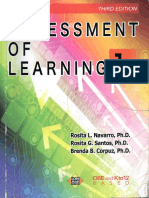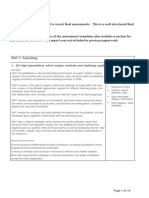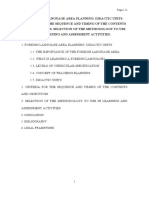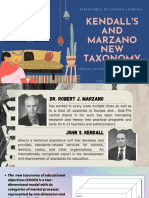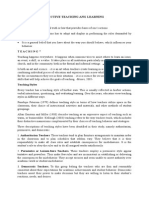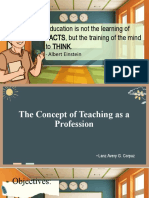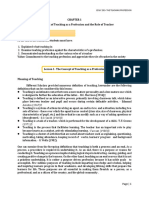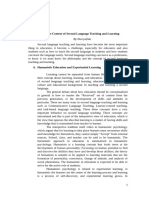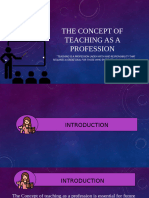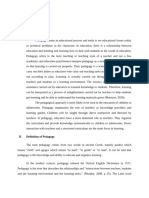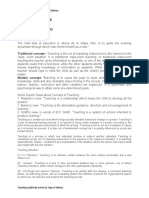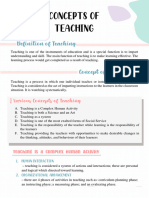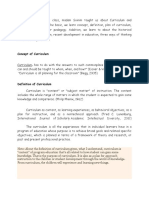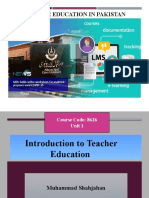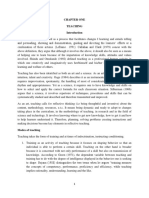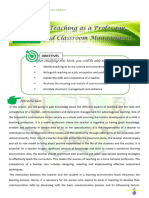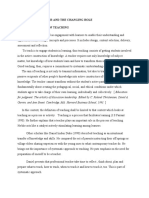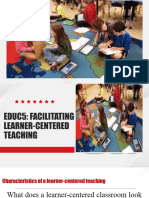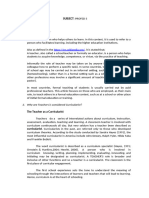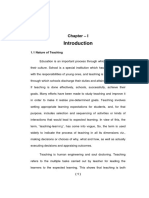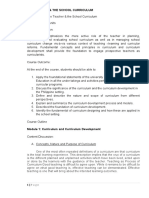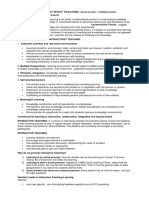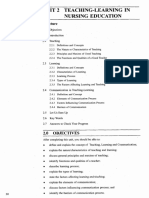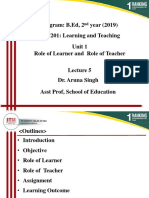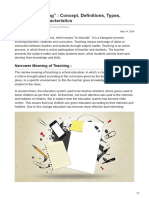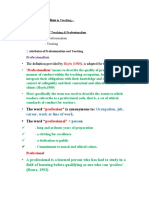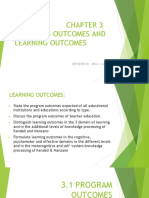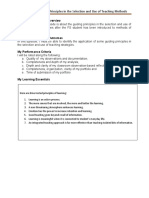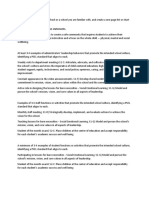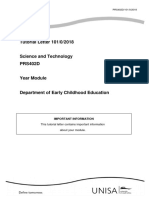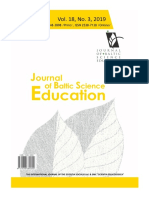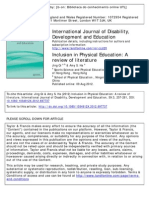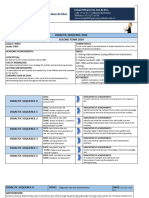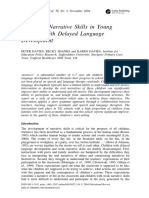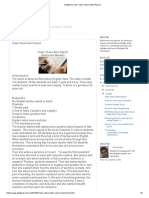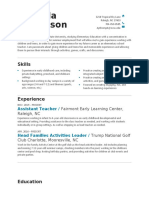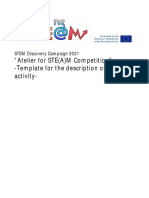Handout 1 - Meaning, Dimension & Metaphors of Teaching
Handout 1 - Meaning, Dimension & Metaphors of Teaching
Uploaded by
Alberth AbayCopyright:
Available Formats
Handout 1 - Meaning, Dimension & Metaphors of Teaching
Handout 1 - Meaning, Dimension & Metaphors of Teaching
Uploaded by
Alberth AbayOriginal Title
Copyright
Available Formats
Share this document
Did you find this document useful?
Is this content inappropriate?
Copyright:
Available Formats
Handout 1 - Meaning, Dimension & Metaphors of Teaching
Handout 1 - Meaning, Dimension & Metaphors of Teaching
Uploaded by
Alberth AbayCopyright:
Available Formats
Handout 1
THE CONCEPT OF TEACHING AS A PROFESSION
Meaning of Teaching
An intimate contact between a more mature personality and a less mature one which is
designed to further the education of the latter (Morrison, 1934)
Teaching is defined as an interactive process, primarily involving classroom talk, which
takes place between the teacher and pupil and occurs during certain definable activities
(Edmund Amidon, 1967)
Teaching is a system of actions involving an agent, an end in view, and a situation,
including two sets of factors - those over which the agent has no control (class size, size
of classroom, physical characteristics of pupils, etc.) and those that he can modify such as
a way of asking questions or ideas gleaned. (Smith, 1969)
Teaching is a task of a teacher which is performed for the development of the child.
(Greens, 1971)
Teaching is the process that facilitates learning. The teacher has an important role to play
because he acts as a catalyst, actively stimulating learning. (Farrant, 1980)
Teaching is a cluster of activities that are noted about teachers such as explaining,
deducing, questioning, motivating, taking attendance, keeping records of works, learners’
progress and background information. (Wells, 1982)
Teaching is both a process and an end. As a process, a procedure is required in undertaking it.
As an end, there is a purpose or reason for conducting it. Teaching as a process implies taking
logical steps in instructing, causing, guiding, and creating positive change in the learners.
Teaching as an end conveys that it is not a pointless undertaking. Rather, it is a purpose driven
profession because it has noble goals to accomplish. Some of the sublime purposes of teaching
include imparting knowledge and wisdom, helping and inspiring learners progress in their
academics, and developing lifelong skills that prepare the learners for life. These purposes are
essential in developing the learners as persons, professionals, and as citizens.
Dimensions of the Teaching Profession
1. The Why of Teaching (Entering the Profession)
There are diverse reasons for choosing teaching as a career
Understanding the “why of teaching” is important among pre-service teachers
because it gives them a point of reflection on the purpose of entering the teaching
profession
The classroom behavior and teaching performance of a teacher is a reflection of
his/her ultimate intention in choosing the teaching career
2. The Who of Teaching (Learners)
Learners are the reasons for the existence of teachers, schools and school
administrators
Pre-service teachers must have a good grasp of the nature of learners such as their
differences, motivations, learning styles, intelligences, socio-cultural
backgrounds, and academic performance.
3. The When of Teaching (Evolution of Teaching in the Philippines)
Teaching is an evolving profession and is continually changing across time
The 21st century presents a different social landscape for learners and necessitates
changing the mindset of pre-service teachers in determining what to teach, how
to teach, and where to teach.
Pre-service teachers should understand the transition of Philippine education and
its historical growth because it is essential in analyzing the educational reforms
and trends of the teaching profession in the country.
4. The How of Teaching (Pedagogy)
Teachers should find means and ways to enhance learning of students
Teachers should have varied teaching strategies and techniques and principles of
teaching. These will make them present and discuss things differently.
Teachers should employ varied teaching approaches and utilize meaningful
activities that evoke better learning outcomes.
Teachers should present their subject matter creatively and uniquely.
5. The What of Teaching (Curriculum)
This includes the educational content, goals and intended outcomes as well as
competencies to be taught and developed among the learners.
The curriculum is the roadmap of all the activities in the school and the ultimate
measure of the results of instruction.
The curriculum defines what the learners should learn, how they will learn it, and
why they have to learn it.
6. The Where of Teaching (Field Placement)
The place for teaching and learning is evolving
Learners are no longer confined in the four walls of the classroom. They may be
fielded in hospitals, industries, communities, and the like to observe how theories
are put into practice.
Pres-service teachers should be updated of the various alternative venues of
teaching considering the learning needs, interests, circumstances, and abilities of
the learners.
Metaphors of Teaching
1. Teaching as an Art
Teachers are considered as artists because they demonstrate creativity, reflection
and innovation in their work. Like an artist, a teacher use teaching as a medium to
express themselves.
Teachers stimulate learners’ thoughts and emotions just like looking at a work of
art which evokes interpretation and appreciation.
The art of teaching is a reflection of the teacher’s personality. In discussing their
lessons, teachers use their own interpretations, experiences, and perspectives
which reflect their own self-expression.
The methodologies employed by teachers are forms of arts because they create,
innovate, and strategize.
Inspiring learners to pursue and enjoy learning is also an art.
2. Teaching as a Science
Science is an organized or systematic body of knowledge that springs from
empirical evidences. Teaching is done in a systematic and orderly manner.
Teaching entails deep knowledge and application of effective techniques
emanating from empirical studies.
The content (theories and principles) and process (pedagogical approaches) of
teaching are the results of research-based processes and practices promoting
learner achievement.
Most learning theories are products of intensive experimentation and laboratory
tests.
3. Teaching as a Craft
A craft requires a kind of skilled work that undergoes planning and executing
process in order to produce a product or object. It involves careful attention to
detail.
Teachers are like conductors of a symphony who combine the science of learning
and the art of teaching through their creativity and talent. Teachers study theories
of human development, learning, pedagogy, classroom management,
communication, and relationships, among others, in order to connect
meaningfully with learners.
4. Teaching as a Mission
The word mission comes from the Latin word “misio” which means “to send”.
Therefore, teaching as a mission connotes that one or an organized group is sent
to accomplish a mission.
Teachers are commissioned to accomplish a task or perform a service. Such tasks
include developing the human resources of the country and transforming lives of
learners for the better.
Mission is also defined as a “task assigned”. If teachers have to perform an
assigned task, they need to render their commitment, obtain adequate
preparation or training, and pursue continuing professional education.
5. Teaching as a Vocation
Vocation is synonymous with “summon” as it comes from the Latin word “vocare”
which means “to call”.
It is also defined as a strong desire to spend one’s life dong a certain kind of work.
Teachers are called to teach because they have a strong inclination in partaking in
the total formation and transformation of young people.
Teaching as a vocation means lifetime commitment. Teachers teach with passion
and touch lives through the years.
You might also like
- TEXTBOOK - Assessment of Learning 1Document143 pagesTEXTBOOK - Assessment of Learning 1Alberth Abay89% (18)
- Module 1 - Ped 02 - The Teaching Profession (Revised)Document31 pagesModule 1 - Ped 02 - The Teaching Profession (Revised)Lawrence Diola83% (6)
- 4g NQT Final Assessment Good ExampleDocument11 pages4g NQT Final Assessment Good ExampleArt DollosaNo ratings yet
- Topic 21Document8 pagesTopic 21Mvp LoloNo ratings yet
- Kendall'S AND Marzano NEW Taxonomy: Prepared By: Jonalyn I. Camila (GROUP 3)Document20 pagesKendall'S AND Marzano NEW Taxonomy: Prepared By: Jonalyn I. Camila (GROUP 3)Alberth Abay100% (1)
- Chapter 1 The Concept of Teaching As A ProfessionDocument18 pagesChapter 1 The Concept of Teaching As A ProfessionJomar Diego100% (3)
- Nature of Teaching and Teacher RolesDocument27 pagesNature of Teaching and Teacher RolesBaby Gie Tausa100% (2)
- Principles of Teaching AgnoDocument9 pagesPrinciples of Teaching AgnoJayCesar0% (1)
- Lesson 1Document6 pagesLesson 1Florens Genoves BagatNo ratings yet
- Educ 104 Module 1Document3 pagesEduc 104 Module 1Real Deal IIINo ratings yet
- Educ 104 Module 1 6Document18 pagesEduc 104 Module 1 6Denver Pol FernandezNo ratings yet
- Lecture in Principles of Teaching (Preliminary)Document14 pagesLecture in Principles of Teaching (Preliminary)Jee En BeeNo ratings yet
- Chapter 1Document44 pagesChapter 1MaricelNo ratings yet
- Abigail D.Document17 pagesAbigail D.abigailNo ratings yet
- Educ 5a Week 1 ModuleDocument5 pagesEduc 5a Week 1 ModuleJee En BeeNo ratings yet
- The-Teaching-Profession-Chapter 1Document16 pagesThe-Teaching-Profession-Chapter 1Jay An Guma GiloNo ratings yet
- Teachingprof ReviewerDocument17 pagesTeachingprof Reviewergh52j6nrt5No ratings yet
- The Context of Second Language Teaching and LearningDocument5 pagesThe Context of Second Language Teaching and LearningNursyafidaNo ratings yet
- The Concept of Teaching As A ProfessionDocument52 pagesThe Concept of Teaching As A Professionmaritesmaquiniana2No ratings yet
- Summary Reading Kajian PedagogikDocument23 pagesSummary Reading Kajian PedagogikskolastikanoeNo ratings yet
- Teaching Aptitude 1Document6 pagesTeaching Aptitude 1Abhishek gargNo ratings yet
- M116 - Module 1Document15 pagesM116 - Module 1Annie Rose A. MaghuyopNo ratings yet
- Chapter 7 ReportingDocument33 pagesChapter 7 ReportingNeliza SalcedoNo ratings yet
- Philosophies of EducationDocument44 pagesPhilosophies of EducationGenelyn JamisolaNo ratings yet
- Concepts of TeachingDocument3 pagesConcepts of TeachingMoises Embalzado Bacus Jr.100% (1)
- Chapter 7 Reporting PDFDocument33 pagesChapter 7 Reporting PDFNeliza SalcedoNo ratings yet
- Concept of CurriculumDocument14 pagesConcept of CurriculumGretz DoriaNo ratings yet
- Unit 1 8626Document28 pagesUnit 1 8626Neelam ZahraNo ratings yet
- EDUC 102 Lessons 1 2 Part of LM 1 MidtermDocument20 pagesEDUC 102 Lessons 1 2 Part of LM 1 MidtermRosie ToszieNo ratings yet
- Assignment #01: Subject: Philosophy of Education Course Code (8609)Document14 pagesAssignment #01: Subject: Philosophy of Education Course Code (8609)Engr SobiaNo ratings yet
- Ped 04 DocDocument4 pagesPed 04 DocJake Arman Principe100% (1)
- Teacher EducationDocument53 pagesTeacher EducationShah JunaidNo ratings yet
- Teaching and Learning by PoojaDocument16 pagesTeaching and Learning by PoojababyNo ratings yet
- Influence of Teachers On Learning EnvironmentsDocument18 pagesInfluence of Teachers On Learning EnvironmentsMargaret NdunguNo ratings yet
- Cim 210 NotesDocument127 pagesCim 210 NotesJay up100% (4)
- Emano, Marie Ann Diane Module 1Document22 pagesEmano, Marie Ann Diane Module 1Marie Ann Diane EmanoNo ratings yet
- 1 Lect Teaching LCT 1 2022.2023Document2 pages1 Lect Teaching LCT 1 2022.2023BWENGYE NICHOLASNo ratings yet
- TTP OutlineDocument5 pagesTTP OutlineVanessa PoquitaNo ratings yet
- The Teaching ProfessionDocument5 pagesThe Teaching ProfessionShiela mae FloresNo ratings yet
- Mystical Rose College of Science and Technology Mangatarem, Pangasinan Module 1 in Theory / Concept 104 The Teaching Profession Lesson 1: Your Philosophical HeritageDocument5 pagesMystical Rose College of Science and Technology Mangatarem, Pangasinan Module 1 in Theory / Concept 104 The Teaching Profession Lesson 1: Your Philosophical HeritageAlyssa Jane NarvasNo ratings yet
- Teaching AptitudeDocument6 pagesTeaching AptitudePraveen Kumar P100% (3)
- Educ5 Unit 1Document33 pagesEduc5 Unit 1ljlydelann2004No ratings yet
- PROFED5 PILI Assignment 1Document5 pagesPROFED5 PILI Assignment 1pilihinyrioNo ratings yet
- Pedagogy 2Document84 pagesPedagogy 2debelaNo ratings yet
- 05 - Chapter 1 PDFDocument65 pages05 - Chapter 1 PDFRifa YupitaNo ratings yet
- Teaching Learning ProcessDocument35 pagesTeaching Learning Processbaji mon tkNo ratings yet
- 1 ST Lecture Teaching SkillsDocument17 pages1 ST Lecture Teaching Skillssam.a.a4007No ratings yet
- The Teacher and The School Curriculum Manuscript Final EditedDocument116 pagesThe Teacher and The School Curriculum Manuscript Final EditedClaire RedfieldNo ratings yet
- Constructivist TeachingDocument4 pagesConstructivist TeachingJhulie San NicolasNo ratings yet
- TEACHING PDFDocument9 pagesTEACHING PDFkariuki.gidrafNo ratings yet
- Unit 2 Teaching-Learning in Nursing Education: ObjectivesDocument28 pagesUnit 2 Teaching-Learning in Nursing Education: ObjectivesLALRINTLUANGI CHHAKCHHUAKNo ratings yet
- CHAPTER 1 The Teaching Profession and Teaching ScienceDocument7 pagesCHAPTER 1 The Teaching Profession and Teaching ScienceJulius MacaballugNo ratings yet
- Chap I (GMT)Document13 pagesChap I (GMT)Syed Hassan Abbas ZaidiNo ratings yet
- Teaching Learning ProcessDocument14 pagesTeaching Learning ProcessSahaj ArjNo ratings yet
- Role of Learner and TeacherDocument18 pagesRole of Learner and Teacherrenu50% (2)
- MODULE 2 Teaching ProfessionDocument10 pagesMODULE 2 Teaching ProfessionBeberly Colon100% (2)
- What Is Teaching Concept Definitions Types Nature and CharacteristicsDocument7 pagesWhat Is Teaching Concept Definitions Types Nature and Characteristicsafzalchinjni3No ratings yet
- ELT 523 - Professionalism in TeachingDocument35 pagesELT 523 - Professionalism in TeachingSucy GipintsNo ratings yet
- Chapter 1Document8 pagesChapter 1carl cambaNo ratings yet
- Teacher's In-Depth Content Knowledge: Model Shulman (1986)Document6 pagesTeacher's In-Depth Content Knowledge: Model Shulman (1986)pdb16230% (1)
- Chapter TwoDocument10 pagesChapter TwoAzhari AzhariNo ratings yet
- Philosophies of EducationDocument17 pagesPhilosophies of EducationDr. Ritchan Roy A. BorjaNo ratings yet
- POT - What Is Teaching and A Teacher?Document7 pagesPOT - What Is Teaching and A Teacher?jhayceehalos.1No ratings yet
- Sony Kdl-55W800B Device Driver Netlinx ApiDocument17 pagesSony Kdl-55W800B Device Driver Netlinx ApiAlberth AbayNo ratings yet
- Programs Outcomes and Learning Outcomes: Reported By: Jesil S. CaceresDocument9 pagesPrograms Outcomes and Learning Outcomes: Reported By: Jesil S. CaceresAlberth AbayNo ratings yet
- 1.3 - 4 Levels of Outcome-Based EducationDocument7 pages1.3 - 4 Levels of Outcome-Based EducationAlberth AbayNo ratings yet
- Sample Touch Panel UsageDocument5 pagesSample Touch Panel UsageAlberth AbayNo ratings yet
- DialogueDocument5 pagesDialogueKevin PiamonteNo ratings yet
- Neust Edu F007 Student Teacher Rating FormDocument2 pagesNeust Edu F007 Student Teacher Rating Formedmund.guevarraNo ratings yet
- FS 2 - Episode 7 Guiding Principles in The Selection and Use of Teaching MethodsDocument10 pagesFS 2 - Episode 7 Guiding Principles in The Selection and Use of Teaching MethodsHenry Kahal Orio Jr.No ratings yet
- w1 Cultural Functions in PracticeDocument2 pagesw1 Cultural Functions in Practiceapi-559674827No ratings yet
- Methodology of Application of Digital Technologies in Primary EducationDocument4 pagesMethodology of Application of Digital Technologies in Primary EducationEditor IJTSRDNo ratings yet
- PRS402D 101 - 2018 - 0 - eDocument26 pagesPRS402D 101 - 2018 - 0 - eYeshmaine Mahadeo0% (1)
- Learning Action Cell ReflectionDocument4 pagesLearning Action Cell ReflectionKrisha MaataNo ratings yet
- Bai Day Online Lop 6Document5 pagesBai Day Online Lop 6Ái ĐinhNo ratings yet
- English (Learning Disabilities) Year 4Document90 pagesEnglish (Learning Disabilities) Year 4Shantini MenonNo ratings yet
- Edu ReformDocument17 pagesEdu ReformNikita NelsonNo ratings yet
- Pedagogical Journey of Pre-Service Teachers StorieDocument20 pagesPedagogical Journey of Pre-Service Teachers StorieMark neil a. GalutNo ratings yet
- Unit 012 Principles of Assessment in Lifelong Learning: PttlsDocument10 pagesUnit 012 Principles of Assessment in Lifelong Learning: Pttlsmailz2yasirNo ratings yet
- Journal of Baltic Science Education, Vol. 18, No. 3, 2019Document169 pagesJournal of Baltic Science Education, Vol. 18, No. 3, 2019Scientia Socialis, Ltd.No ratings yet
- Inclusion in Physical Education. A Systematic Review of LitratureDocument26 pagesInclusion in Physical Education. A Systematic Review of LitratureMiguel PlenoNo ratings yet
- English Project 1Document31 pagesEnglish Project 1Shashwat PratyushNo ratings yet
- Napont Zach ResumeDocument3 pagesNapont Zach Resumeapi-516152114No ratings yet
- Absenteeism and TruancyDocument12 pagesAbsenteeism and TruancyLuis Soto ProvosteNo ratings yet
- 2 Term Math FirstDocument10 pages2 Term Math FirstKaren SolanoNo ratings yet
- Improving Narrative Skills in Young Children With Delayed Language DevelopmentDocument17 pagesImproving Narrative Skills in Young Children With Delayed Language DevelopmentCamila Muñoz VergaraNo ratings yet
- English For Life - Class Observation ReportDocument4 pagesEnglish For Life - Class Observation ReportMARCELGENIONo ratings yet
- Amandathompson ResumeDocument2 pagesAmandathompson Resumeapi-402459656No ratings yet
- Digital Art With Weave SilkDocument9 pagesDigital Art With Weave SilkCristina Teodora BarbuNo ratings yet
- Teacher Arrested For Alleged Rape of 13-Year Old StudentDocument2 pagesTeacher Arrested For Alleged Rape of 13-Year Old StudentJunna Marie DiosesNo ratings yet
- Observation Write-UpDocument3 pagesObservation Write-UpMaggiə Kəarns100% (1)
- BSK Final1Document38 pagesBSK Final1Jalal HADJI AMERNo ratings yet
- FS1 - Ep5Document5 pagesFS1 - Ep5mackuhmacutayNo ratings yet
- Animal Legs LessonDocument7 pagesAnimal Legs Lessonapi-374359720100% (1)
- Docshare - Tips - Factors Affecting The College Course PreferenceDocument81 pagesDocshare - Tips - Factors Affecting The College Course PreferenceNiña Jane TaclingNo ratings yet
